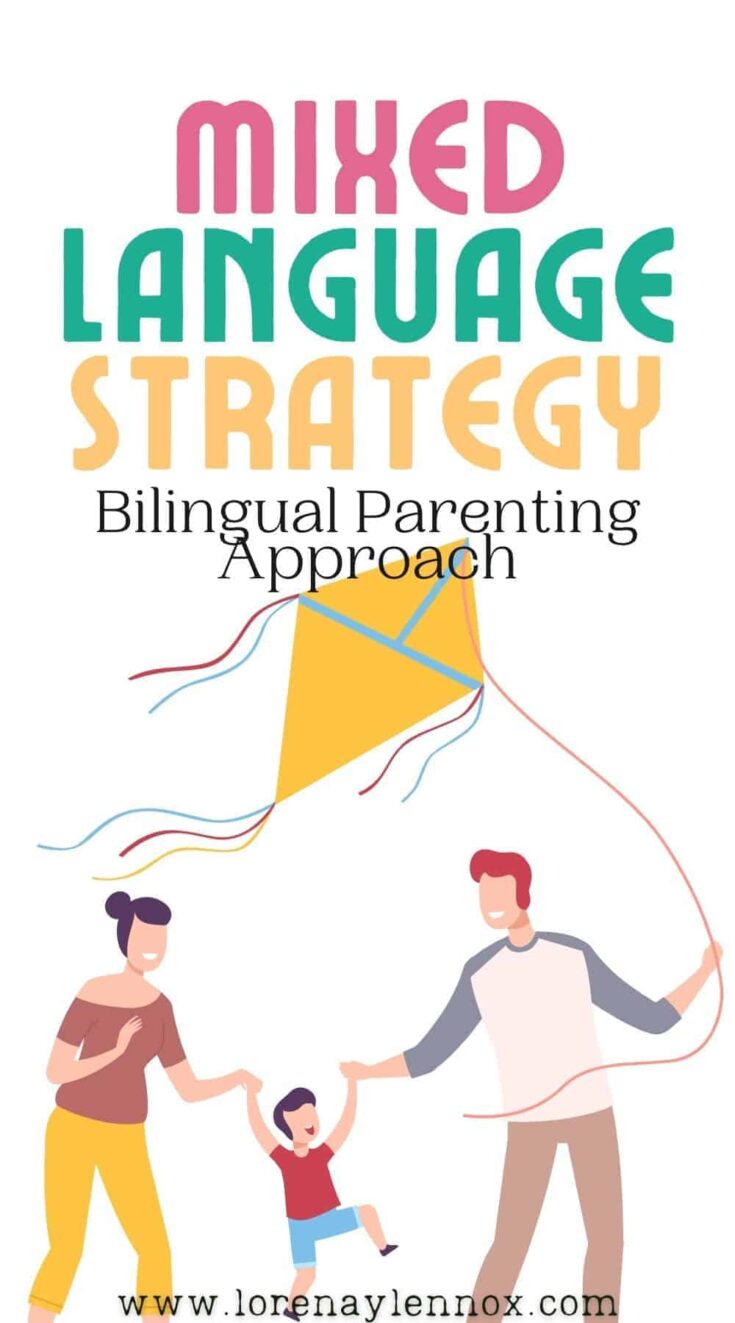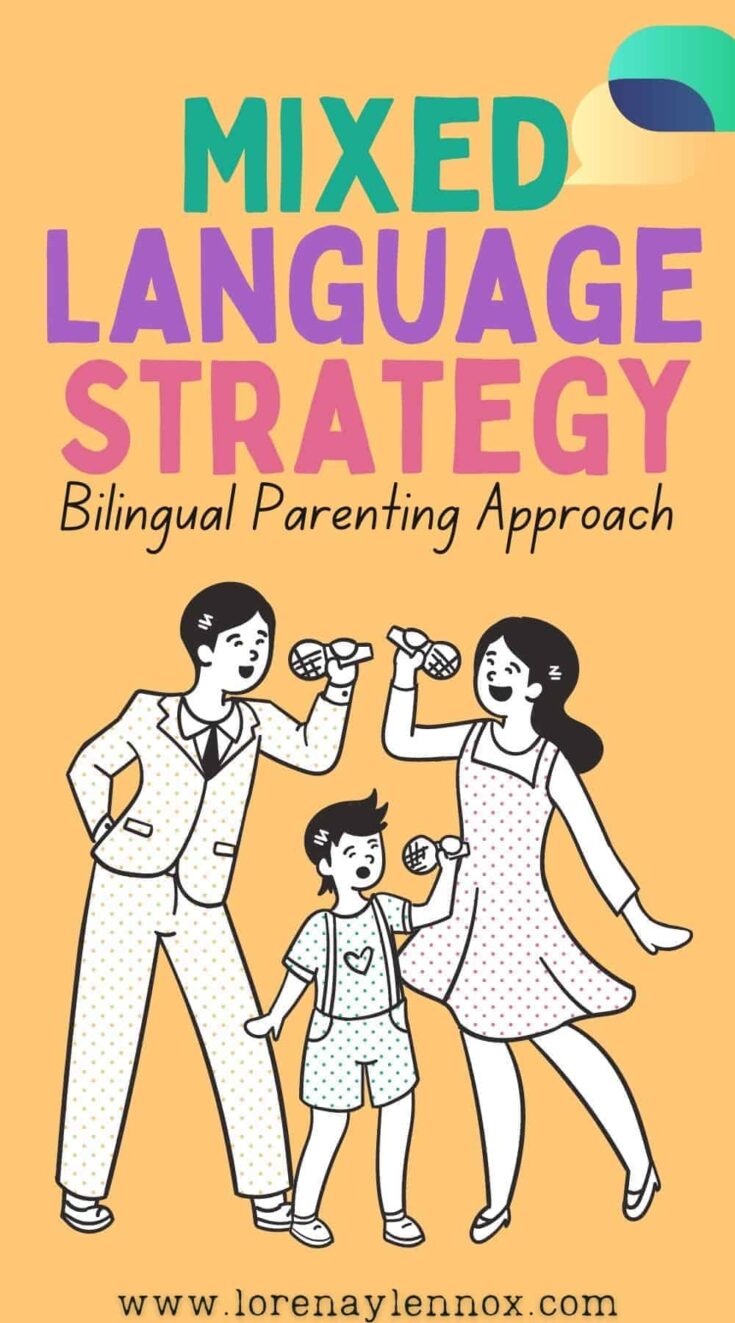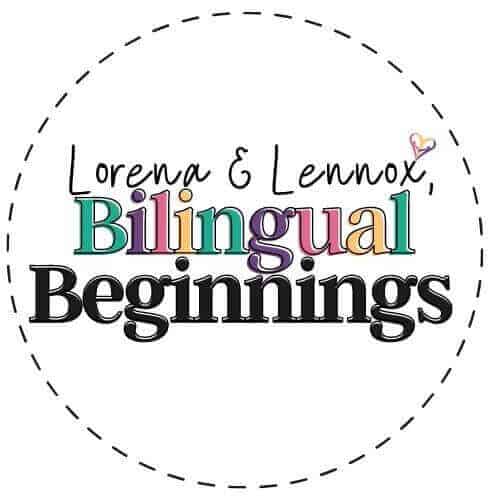Today I want go into the fourth bilingual parenting approach, the mixed language strategy.
Interestingly enough, this method is pretty common, and many parents use it without even knowing that they are.
In our household, we started out using the Minority Language at Home approach, and we are slowly switching over to the mixed language strategy.
Over the past few weeks, I have been researching this strategy and I want to share with you what I have learned thus far.
With time, I hope to incorporate my own observations our mixed language strategy bilingual journey. Stay tuned!
What language strategy are you using in your bilingual household? Let me know in the comments below?
If you’re not sure about your bilingual parenting strategy, need guidance, or want to know more about raising bilingual kids, follow us on Instagram or Facebook. You can also subscribe to this blog for weekly bilingual parenting tips and free resources in Spanish!
Enjoy, now on to learn more about the mixed language strategy to see if it is suitable for your family!

What is the Mixed Language Strategy?
The Mixed Language Strategy is relatively straightforward. Both parents use both the minority and the majority languages with their child(ren).
Mixed language strategy is most commonly seen among bilingual communities such as immigrant enclaves or expat communities.
Unlike the other three bilingual parenting approaches— Minority Language at Home, One Person, One Language, and Time and Place, there are no set rules or guidelines for using each language with the mixed language strategy.
The languages are used interchangeably, in the most natural, organic way.
A dialogue might begin in the minority language and end in the majority language or vice versa.
You might be thinking, well, won’t this cause language confusion? No! Language confusion is a bilingual parenting myth!
Children distinguish their languages from early on. According to Kendall King and Alison Mackey in their book The Bilingual Edge,
“Mixing languages is a normal phase of bilingual language development. It seems to be near-universal among bilingual children and is apparent even at the babbling stage; that is, long before children can say a word in any language.” (27)

As a bilingual myself, I mix languages in almost every sentence if I speak with another bilingual. Some phrases and words are just easier to say in one language over the other. (This mixing of languages, called code-switching is how new languages and dialects come about, like Spanglish— yes, it’s a language!)
Thus, with the mixed language stategy, the focus is not the separation of languages but rather the amount of input given in each language.
This is where the mixed language strategy gets a bad wrap.
If there is not an adequate amount of input in the minority language, this can lead to passive bilingualism. However, if there is an emphasis on the minority language in the household, there is a 93% chance that a child will grow up to be full-fledged active bilingual. (Ruiz Martín 130).
We will get more into this further down in the advantages and disadvantages section of this post.
What type of families use the Mixed Language Strategy?
Below are some examples of families that might use the mixed language strategy approach.
Example 1: A minority language expat family. Two German-speaking parents that have lived in London for several years now and have great control over the English language. They are raising their child in London in German and English.
Example 2: A second-generational immigrant family from Guatemala living in a Latino enclave in the D.C. Metro area. Both parents were born and raised in the United States and speak both English and Spanish. They are unintentionally raising bilingual children because they speak Spanish and English to their two children at home.

Example 3: One minority-language parent and one nonnative minority language speaking parent. For instance, in my situation!
My partner is from El Salvador, and I am a forever student of the Spanish language. We got together a few years back and committed to raising our children in Spanish first! Woohoo! Carlos speaks a good amount of English, and I have high competency in Spanish, and now that we have transitioned to this approach, you can find our conversations weaving in and out of Spanish and English.
However, we made it a rule that the family conversations should be primarily in Spanish. Also, when our son Lennox speaks with his papi, it should be in Spanish. This allows for sufficient minority language input. Doing this lightens my nonnative load and allows me to indulge in my native tongue with my son!
Example 4: Two nonnative minority language-speaking parents. Two people fell head over heels in love with each other once they locked eyes in Italian class. They traveled and solidified their Italian over the years and decided to raise their kids in Italian and English in the United States.
Okay, so what’s the common denominator here? All of the parents in each scenario are bilingual! Maybe they didn’t grow up bilingual, but they all have an excellent command of the minority language and thus can easily communicate in that language with their children.
While some parents might intentionally be raising their kids bilingually using the mixed language strategy, others live in an enclave where mixing languages is a phenomenon that occurs naturally in the community.
Advantages of the Mixed Language Strategy
In her amazing podcast The Bilingual Parenting Podcast episode 007 “Mixed Language Families (FLP Series Part 4) “ Kaila Díaz goes into the advantages and disadvantages of the Mixed Language Strategy. In the next two sections, I will highlight her most important points!
- It is bilingualism in “its natural form.”
Parents are free to access both languages, at any time, on any occasion. It loosens the slack on exact rules and parameters.
- It’s low pressure for parents and kids
The mixed language strategy allows children and parents to interact naturally.
In my case, as Lennox grows and his speech develops, it gets more challenging for me, as a non-native speaker, to express myself naturally with him in Spanish.
In the past, when we were using the MLAH approach, I would feel a pang of guilt if I spoke to Lennox in English. However, now that we are transitioning to the mixed language strategy, I can relax and talk to Lennox in English when I am with him one-on-one, and in a family setting, we all speak Spanish.
Also, it allows Lennox to see me as my true self.
Did you know that some people have different personalities when they speak different languages? For example, I am a little wittier and more sarcastic in English, but when I speak in Spanish it doesn’t come out as such. So, therefore, I enjoy being able to show Lennox that side of me.

- It emphasizes communication instead of who speaks what, allowing the bilingual child to feel heard, rather than simply understood.
- The parents stand as an accurate representation of what adult bilingualism looks like and how it works.
Disadvantages of the Mixed Policy Language Method
Disadvantages of the Mixed Language Family Method
In her podcast, Kaila also mentions some disadvantages of the mixed language family.
- Lack of monolingual conversational skills.
If the child is not receiving sufficient exposure in both languages, the child might experience difficulties having conversations with monolingual speakers.
That is to say that not everyone in the child’s life will be bilingual or bilingual in the same languages. Therefore if the child is constantly code-switching between languages, it might be challenging to converse in one language with a monolingual person.
Kaila recommends developing both of the languages in a “monolingual context, in addition to bilingual context” to “flex the linguistic muscle in both languages separately so that they’ll be prepared for future conversations with people that only speak one language.” (15’25)
- Parents might use this approach without a strategy or with a lack of intentionality.
Bilingualism requires lots of exposure and input in the minority language. Therefore, if a parent is not intentional about their child’s bilingualism, it could diminish their proficiency in the minority language.
It can also lead to passive bilingualism. Passive bilingualism is when the child can understand the minority language but cannot communicate in it.
Kendall King urges mixed language families to consider providing extra support for the minority language inside the home. He exclaims that a family should speak 80 percent in the minority language and 20 percent in the majority language for best results.

- A potential decline in bilingualism overtime
A family might nurture the minority language in the first years with their child. Still, with time, the child is more and more exposed to the majority language, which can cause a decline in their bilingualism, especially if the parents start speaking the majority language more to the child.
Furthermore, a child might grow to favor one language over the other and give pushback to speaking in the minority language with the parents.
Tips for using the family language strategy
- Be more intentional about nurturing the minority language at home as much as possible.
- Add some structure or guidelines to your mixed language policy to ensure proper minority language input.
For example, in my bilingual family (my partner is from El Salvador with a native language in Spanish and me, a nonnative Spanish speaker), we speak in Spanish or Spanglish as a family.
Both my partner and I are with Lennox for the same amount of time. I am a little more lenient and speak 50/50 Spanish and English when I am with my son. As the minority language speaker, my partner speaks in Spanish with Lennox as much as possible.
At preschool, Lennox gets an entire 2.5 hours a day only in English.
- Monitor the quantity and quality of language input and exposure and limit technology for minority language input. When you do use technology, keep it in the minority language.
Related: YouTube Channels in Spanish for Toddlers
- Be on the alert because the majority language will seep into every aspect of your child’s life. Try to foster the minority language as much as possible in the early years! From birth through the preschool years is when a child can soak up a language the best!
- Read in the minority language as much as possible.
- Keep the minority language fun and desirable. Let your child know how important it is for them to carry on the minority language by doing fun, family activities in the minority language. We offer a lot of free printable activities in Spanish that might do the trick!
- Carve out individual time for each language throughout your days/weeks/months.
Well, I hope this introduction to the mixed language strategy will guide you in your own bilingual parenting journey!
Don’t forget to share your language strategy in the comments below!
Don’t forget follow us on Instagram or Facebook and subscribe to this blog for weekly bilingual parenting tips and free resources in Spanish!
Related posts you might enjoy:
- 13 Facts About Raising Bilingual Children
- Time and Place Bilingual Parenting Approach
- How To Read To Your Child in the Minority Language


Anna Braz
Thursday 29th of February 2024
I'm so glad I found your blog! Me and my husband are about to start our family and I am a native English speaker and he is a native Brazilian Portuguese speaker!! I've been worried about how we are going to raise our children to be bilingual as my Portuguese is fluent but not native. this blog is my lifesaver and I am now excited to start our future family's bilingual journey!! thank you
Lorena
Friday 1st of March 2024
Anna,
I am so glad you found my blog! Please make sure to find me on Instagram or Facebook and reach out so we can connect!